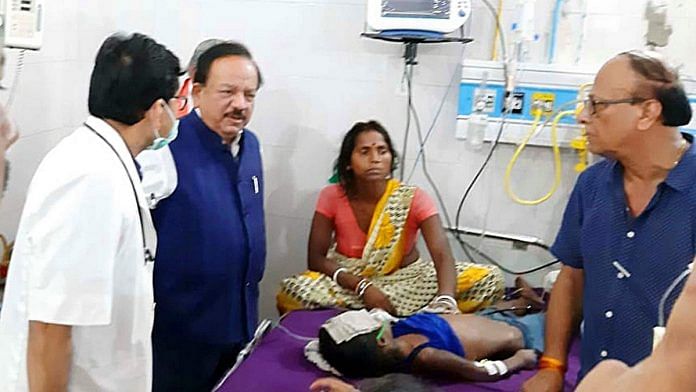New Delhi: Nearly 100 children have died in Bihar’s Muzaffarpur this June amid an encephalitis outbreak, 43 of them aged below 10.
While Bihar Chief Minister Nitish Kumar has announced an ex-gratia sum of Rs 4 lakh to each of the families that has lost a child to Acute Encephalitis Syndrome (AES), Union Health Minister Dr Harsh Vardhan, said he had asked “every official and every minister to ensure that everything is being done to fight this disease”.
Meanwhile, state health officials have sought to blame the deaths on hypoglycemia, or low glucose, which they say is an aspect of encephalitis.
As authorities seek to rein in the toll, ThePrint looks at the ongoing outbreak of encephalitis in Bihar, the nature of the disease, its correlation with hypoglycemia and how to treat it.
Background to the outbreak in Bihar
Since January, 172 children below the age of 10 have been admitted in Muzaffarpur hospitals for suspected AES.
AES was first reported in Muzaffarpur and its surrounding areas in 1994, and has remained a challenge for the Bihar government since then.
In 2012, 120 children reportedly died of AES in Muzaffarpur and surrounding areas, while 90 children died in 2014.
Speaking of this year’s outbreak, Bihar health department principal secretary Sanjay Kumar said, “We hope to get some guidelines from the central team. Most deaths occurred due to hypoglycemia. Some of these patients hailed from Sitamarhi, Sheohar, Vaishali and East Champaran districts.”
What is AES?
AES is a neurological disorder. It is an inflammation of the brain, and can be caused by a group of infectious diseases, including chicken pox, meningitis, herpes, rabies, hypoglycemia and malaria.
It can be caused by virus, bacteria, fungi and a range of other agents. For example, Japanese Encephalitis, the major cause of AES in India, is caused by mosquitoes.
Encephalitis starts with either fever or headache, and can escalate to seizures and fits, mental disorientation, delirium, loss of consciousness and even coma.
In 2017, there was a massive outbreak of Japanese Encephalitis in Gorakhpur, Uttar Pradesh, which killed over 500 children.
Alarmed, the UP government soon started a door-to-door campaign to spread awareness and give timely vaccinations. On 25 April 2018, Unicef’s India chapter congratulated Uttar Pradesh “for immunising every child” against Japanese Encephalitis and AES.
AES and hypoglycemia
The Bihar government as well hospital authorities have insisted that the deaths occurring in Muzaffarpur are due to hypoglycemia.
Dr S.K. Shahi, the medical superintendent at Shri Krishna Medical College and Hospital (SKMCH), one of two Muzaffarpur hospitals bearing the brunt of the outbreak, told The Indian Express, “All cases come under the broad term of AES, but people consider it a disease when it is just a syndrome. Hypoglycemia is the specific reason for most deaths.”
According to him, of the 36 deaths reported at SKMCH, 25 were because of hypoglycemia, while there were only two confirmed cases of Japanese Encephalitis.
However, Dr Arun Shah, an executive committee member of the Indian Academy of Paediatrics Association, explained that lack of cleanliness, malnutrition, hot and humid weather conditions were all factors involved in creating conducive conditions for AES. Additionally, Dr Ragini Mishra of the state’s health society was quoted as saying that there was “some correlation” between high temperatures and AES.
While attributing the spate of deaths to hypoglycemia, the state authorities have also pointed to the role the popular fruit lychee may have played. Muzaffarpur is known for its lychees, which reportedly contain toxins “that inhibit the body’s ability to produce glucose”.
According to media reports, Muzaffarpur children often feed on lychees in orchards, even those not fully ripe, and arrive home too full for dinner, going to sleep without eating anything. This factor has been blamed for triggering hypoglycemia in local children.
Officials from the state health department have thus issued an advisory, telling parents to not feed their children lychees and to ensure they do not go to sleep with lychees as their last snack.
How to treat AES
The treatment of AES is mainly bed rest and plenty of fluids. Anti-inflammatory drugs are given to relieve fever and headaches along with anti-viral medication. Corticosteroids are given to reduce brain swelling and anti-convulsants to treat seizures.
Speaking on his Bihar visit, Dr Harsh Vardhan said, “Bihar needs a state-of-the-art research facility to tackle the outbreak of this disease. Other organisations of the country which are involved in finding cure for AES must work together. ”
He further stated that the Ministry of Health was coordinating with the Ministry of Women and Child Development to distribute nutritious food with glucose to prevent AES development.
Also read: Death toll of children in Muzaffarpur acute encephalitis case touches 83




Times Now and Republic TV are turning the heat on CM Nitish Kumar.